Exploring The Majestic Abu Simbel Temples In Egypt
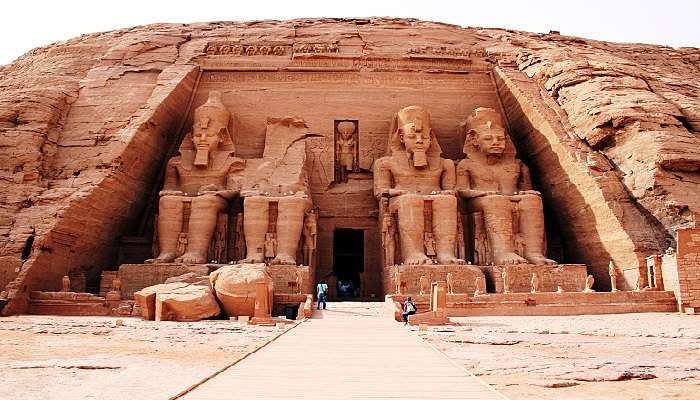
Located near the Sudanese border in southern Egypt are the two breathtakingly beautiful rock-cut monuments known as the Abu Simbel temples. pharaoh Ramesses II erected these well-known archaeological ruins in honour of himself and his queen Nefertari in the 13th century BC out of a sheer rock cliff. The massive grandeur of the temples is remarkable, and they are adorned with massive statues of Ramesses. The whole complex is one of the most astounding examples of ancient engineering and one of the most stunning constructions to have survived from antiquity. These days, pilgrims from all over the globe visit this temple.
About Abu Simbel Temples
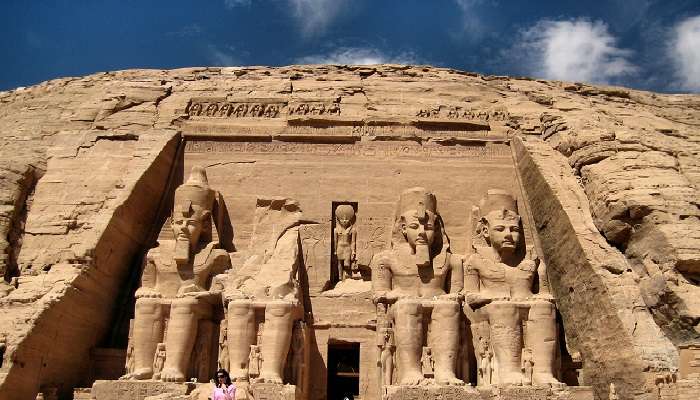
The Abu Simbel temples are two massive rock-hewn temples in southern Egypt, near the Sudanese border. Pharaoh Ramesses II built this in the thirteenth century BC as a lasting homage to himself and his queen Nefertari. The most famous aspect of the temples is the enormous statues of Ramesses II on each side of the great temple entrance. The temples had been covered in sand for many years when Swiss explorer Johann Ludwig Burckhardt discovered them in 1813.
The temples were relocated to higher ground in the 1960s to shield them from the rising waters of Lake Nasser, which were generated by the construction of the Aswan High Dam. This incredible engineering achievement is proof of the Abu Simbel temples’ lasting influence.
Must Read: 4000 Year Old Tomb In Egypt
Abu Simbel Temples History

During Ramesses II’s reign, a prolific building program was initiated across Egypt and Nubia, which Egypt controlled at the time. Nubia was significant for the Egyptians due to its rich deposits of gold and other valuable trade goods. To assert Egyptian dominance and integrate the Nubians into Egyptian culture, Ramesses II commissioned the construction of several grand temples in the region.
The most famous of these temples are the rock-cut temples at the Second Nile Cataract, which separates Upper and Lower Nubia and is close to the present-day hamlet of Abu Simbel. The construction of the Abu Simbel temples began around 1264 BC and continued for approximately 20 years, concluding around 1244 BC. The Great Temple was initially named the “Temple of Ramesses, Beloved by Amun.” These temples served religious and ceremonial purposes and functioned as lasting monuments to Ramesses II’s power and the might of Egypt.
Interesting Facts About Abu Simbel Temples
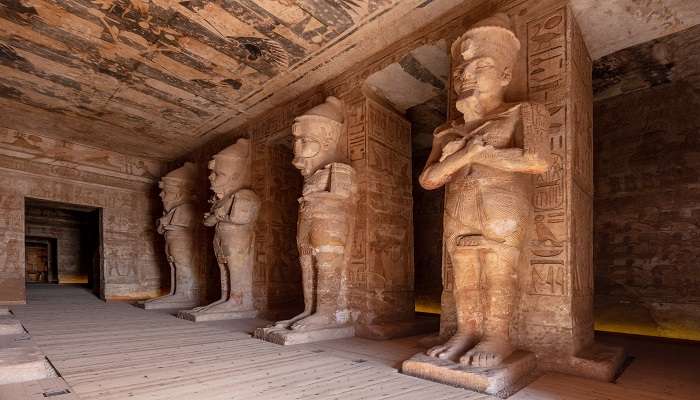
Below are six facts about Abu Simbel temples:
- Geographical Position: The temples are located in Nubia, on the Nile River’s western bank, approximately 230 kilometers southwest of Aswan.
- Architectural Marvel: The Abu Simbel temple complex was erected over two decades to celebrate Ramesses II’s triumph at the Battle of Kadesh and showcase his might and grandeur.
- Structural Layout: The larger Temple of Ramesses II and the lesser Temple of Hathor are the two temples that make up the compound. Both were cut from a sandstone bluff on the western side of the Nile River.
- Monumental Statues: The temples are renowned for their gigantic statues of Ramesses II, each towering over 20 meters tall. The Great Temple houses four statues and several smaller statues of his kin and other deities.
Suggested Read: Things To Do In Marsa Alam
Abu Simbel Temples Architecture And Design
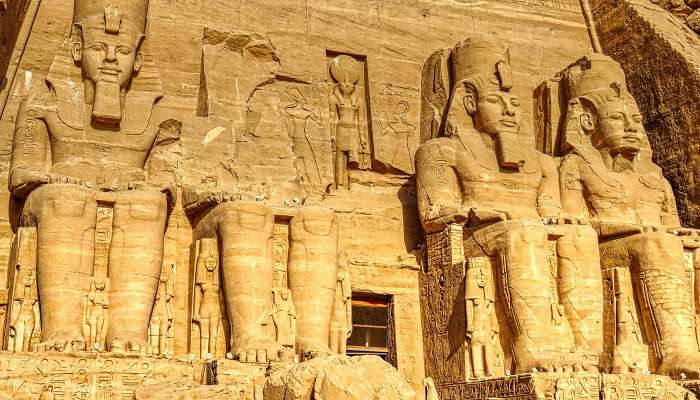
The Abu Simbel complex is home to two magnificent temples. The larger of the two, known as the Great Temple, is an homage to the deities Amun, Ra-Horakhty, and Pharaoh Ramesses II himself. Dominating the entrance are four towering statues of Ramesses II, each reaching a height of 20 meters. The temple’s grand façade, measuring 33 meters in height and 38 meters across, is a monument to the historic peace accord between the Egyptians and the Hittites.
1. Entrance

Four enormous sculptures, each standing 20 meters (66 feet) tall and depicting Ramesses II seated on a throne and donning the two crowns of Upper and Lower Egypt, flank the temple’s single entrance. Beside the king’s limbs are several smaller statues, all no higher than the pharaoh’s knees, representing Ramesses’s first six daughters, his chief wife, his queen’s mother, and his first two sons. The colossi are surrounded by a façade that is 38 meters (125 feet) wide and 33 meters (108 feet) high.
2. Interior

The inner part of the temple follows the typical triangular layout of most ancient Egyptian temples, with the size of the chambers getting smaller as one approaches the sanctuary. Eight gigantic Osirid pillars support the hypostyle hall, also known as the pronaos. It is 18 meters (59 feet) long and 16.7 meters (55 feet) broad. The white crown of Upper Egypt is shown on the enormous sculptures that line the left-hand wall. However, those on the other side don the dual crown of Lower and Upper Egypt (pschent). The hypostyle hall, with its four pillars adorned with exquisite representations of sacrifices to the gods, leads into the second pillared hall. This chamber is decorated with images of Nefertari and Ramesses holding the holy boats of Ra-Horakhty and Amun.
Suggested Read: Famous Landmarks In Egypt
3. Solar Alignment
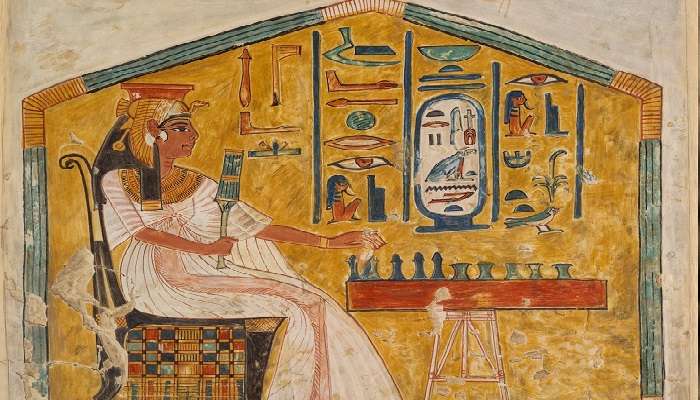
It is believed that ancient Egyptian architects positioned the temple’s axis so that on October 22 and February 22, the sun’s rays would penetrate the sanctuary and illuminate the sculptures. Except for the statue of Ptah.
4. Small Temple
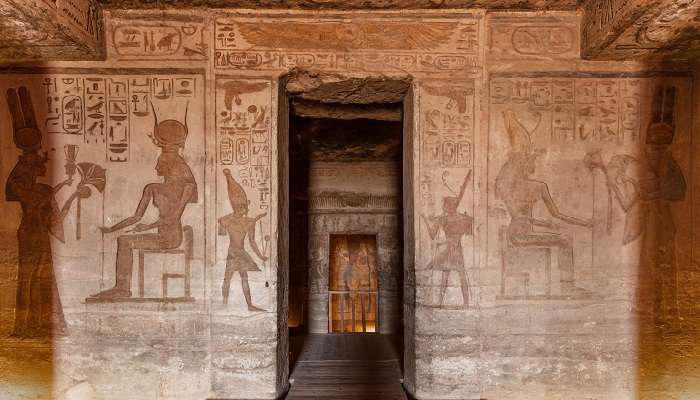
The Small Temple, also known as the Temple of Hathor and Nefertari, is a marvel of ancient architecture. Ramesses II erected it in 1264 BC as an homage to Hathor, the goddess, and Queen Nefertari, his cherished consort. Carved directly into the rock face of a mountain, the temple’s entrance is flanked by six colossal statues. It opens into a grand hall lined with pillars, followed by a perpendicular chamber.
Suggested Read: Best Cities To Visit In Egypt
5. Entrance Fees & Opening Hours
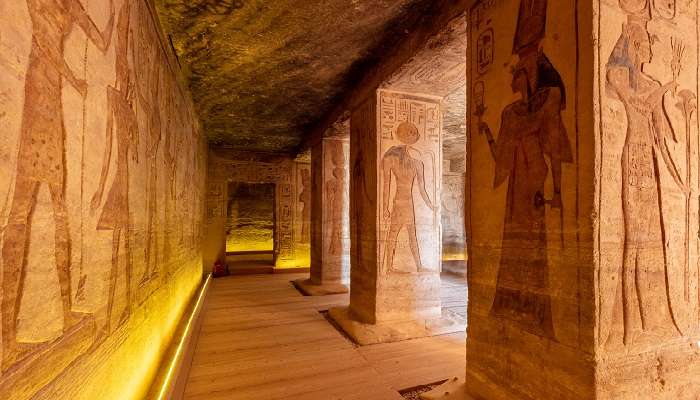
Visitors can explore these architectural marvels from 6 a.m. to 5 p.m. between October and April and up to 6 p.m. from May to September. Entry costs 160 Egyptian pounds (around $10) per adult. However, on special occasions like February 22nd and October 22nd, the entry fee for foreigners is 900 Egyptian pounds for adults and 450 Egyptian pounds for students.
Best Time To Visit Abu Simbel Temples
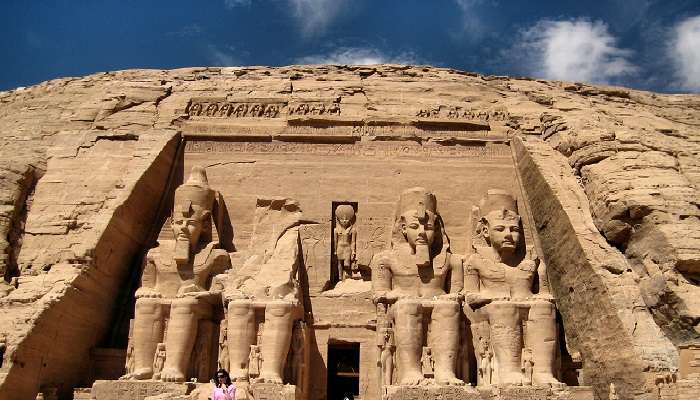
Visiting the Abu Simbel Temples is most favourable during January, February, and December when the weather is more temperate. This is a key consideration due to the area’s typically hot desert climate. For an optimal experience, arriving early, between 4 am and 10:30 am, is advisable. This schedule allows ample time to explore the site and avoids the desert’s peak heat hours from 10 am to 4 pm
Those interested in a special spectacle should note the Sun Festival at Abu Simbel, which occurs annually on February 22 and October 22. This event features a remarkable natural display as the sunbeams light up the Great Temple’s inner chamber.
Suggested Read: Egypt In April
How To Reach Abu Simbel Temples

After reaching Aswan, you can reach Abu Simbel Temples in various ways. Below are the various ways by which you can reach these temples:
By Air
Direct flights are available from Aswan to Abu Simbel, the most convenient and fastest way to the temples. The flight usually takes 45 minutes.
By Road
You can hire a private car or taxi from Aswan. The drive is scenic and takes around 3 hours. Tourist buses also travel from Aswan to Abu Simbel, usually early in the morning, to allow visitors to witness the sunrise at the temples.
By Lake
Some cruises on Lake Nasser include a stop at Abu Simbel, combining comfort with stunning views of the lake and the Sahara Desert.
Further Read: Haunted Places In Egypt
The Abu Simbel Temples are an awe-inspiring archaeological wonder that everyone should experience at least once in their lifetime. The sheer grandeur of the colossal statues and the incredible engineering feat of relocating the entire complex is simply mind-boggling. Seeing these majestic temples in person truly allows you to appreciate the remarkable achievements of ancient Egyptian civilization. Book your trip to Egypt today if you’re ready to be transported back in time and stand in the presence of such historic glory.
For our editorial codes of conduct and copyright disclaimer, please click here.
Cover Image Source: Hedwig Storch for Wikimedia Commons
Frequently Asked Questions About Abu Simbel Temples
Why is Abu Simbel so special?
Abu Simbel is special due to its grandeur and historical and cultural significance. It showcases the architectural brilliance, religious beliefs, and the power of Pharaoh Ramses II. The site is also known for its massive rock relief figures and its complex engineering feat of relocation.
What is the miracle of Abu Simbel?
The miracle of Abu Simbel refers to the biannual solar event where the sun’s rays illuminate the inner sanctuary of the Great Temple. This phenomenon occurs on approximately February 22 and October 22, aligning with Ramses II’s coronation and birthday.
What is inside Abu Simbel?
Inside Abu Simbel, there are two temples with halls adorned with statues and wall carvings. The Great Temple features colossal statues of Ramses II and scenes of his victory at the Battle of Kadesh. The smaller temple is dedicated to Queen Nefertari, showcasing the pharaoh’s affection for her.
What damaged Abu Simbel?
Abu Simbel was threatened by the rising waters of the Nile due to the construction of the Aswan High Dam. The temples were at risk of being submerged, which led to the international effort to relocate them to higher ground.
Why was Abu Simbel removed?
Abu Simbel was removed from its original location to save it from being submerged by Lake Nasser, the reservoir created by the Aswan High Dam. The temples were carefully dismantled and reconstructed on a new site 64 meters above and 180 meters west of their original location in a massive UNESCO-led project.
People Also Read:
Mangaladevi Temple Pura Taman Kemuda Saraswati Chamundeshwari Temple

We all have to begin somewhere. This is where I start and I hope that my writings encourage you to begin. To new beginnings and conquering new places!











